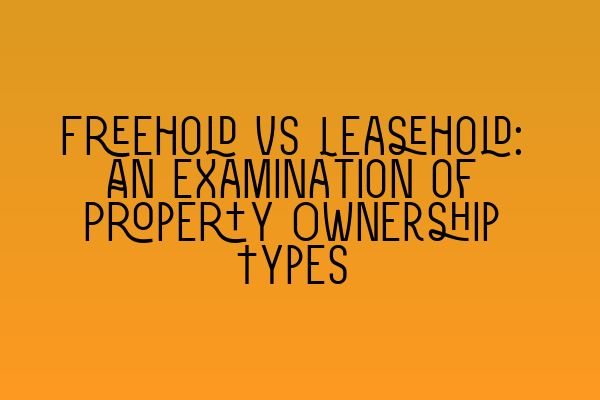Freehold vs Leasehold: An Examination of Property Ownership Types
When it comes to property ownership, there are two main types that you need to be familiar with – freehold and leasehold. Each type has its own unique characteristics and implications for buyers and sellers. In this blog post, we will take an in-depth look at freehold and leasehold, exploring their differences, advantages, and considerations. Whether you’re a property buyer or a solicitor specializing in property law, understanding these ownership types is crucial for navigating the real estate market.
Freehold Ownership
Freehold ownership is the most straightforward and self-explanatory type of property ownership. When you own the freehold of a property, you have complete and absolute ownership of both the land and any buildings or structures on it. This means that you have the right to occupy, use, and develop the property as you see fit, subject to any relevant planning permissions and legal restrictions.
One of the primary advantages of freehold ownership is that you have indefinite tenure. In other words, you own the property for an unlimited duration, and it can be passed on to future generations. This provides a strong sense of security and control over your investment.
Moreover, owning the freehold of a property tends to appeal to buyers who value independence and autonomy in their decisions relating to the property. For instance, you have the freedom to make alterations or improvements to the property without seeking permission from a landlord or management company.
However, it’s important to note that with freehold ownership, you also carry all the responsibilities and costs associated with maintaining the property. These include repairs, maintenance, and building insurance. As a freeholder, you will need to budget for any necessary expenses and ensure that the property remains in good condition.
For further information on preparing for the SQE 1 exam, you can refer to our SQE 1 Practice Exam Questions or our SQE 1 Practice Mocks FLK1 FLK2.
Leasehold Ownership
Leasehold ownership, on the other hand, grants the right to occupy and use a property for a predetermined period of time, as outlined in a lease agreement. With leasehold, you do not own the land on which the property stands; instead, you are effectively leasing it from the freeholder. This means that you have certain obligations and restrictions regarding the use and maintenance of the property.
Leasehold ownership is commonly associated with flats, apartments, and certain types of residential or commercial developments. It is important to note that the lease agreement may stipulate additional costs such as ground rent and service charges, which you will need to budget for in addition to your mortgage repayments.
One of the primary considerations when it comes to leasehold ownership is the lease length. In some cases, the lease may be relatively long – such as 999 years – providing security and stability for the leaseholders. However, short leases – especially those below 80 years – can be a cause for concern, as they may make it difficult to sell the property or obtain finance.
It’s also worth mentioning that leasehold properties often come with additional restrictions, such as obtaining permission for alterations, restrictions on keeping pets, or limitations on subletting. It is important to carefully review the terms of the lease agreement and seek legal advice to understand any limitations or modifications you may require.
To prepare for the SQE 2 exam, you can take advantage of our comprehensive SQE 2 Preparation Courses. If you’re just starting your SQE journey, we also offer SQE 1 Preparation Courses to help you develop a strong foundation in legal knowledge.
Which Ownership Type Is Right for You?
Deciding between freehold and leasehold ownership ultimately depends on your personal circumstances, preferences, and long-term goals. Freehold ownership provides greater autonomy and control over the property, but it also comes with greater responsibilities and costs. Leasehold ownership offers a more affordable initial investment, but it entails ongoing lease obligations and limited control over the property.
When considering property ownership, it is essential to seek advice from a qualified property lawyer who can guide you through the advantages, disadvantages, and legal implications of each ownership type. They can help you assess the terms of the lease, negotiate changes where possible, and ensure that you make an informed decision based on your unique needs and circumstances.
For a complete guide on preparing for the SQE exams, including important exam dates and other useful resources, visit our article on SRA SQE Exam Dates.
Conclusion
Freehold and leasehold ownership are two distinct types of property ownership, each with its own benefits and considerations. Freehold ownership offers complete control and indefinite tenure, while leasehold ownership provides a more affordable investment option with certain restrictions and obligations.
As a property buyer or a solicitor specializing in property law, understanding the nuances of freehold and leasehold ownership is crucial for effectively advising clients and navigating the real estate market. By considering your own goals, consulting legal professionals, and staying informed about industry developments, you can make confident and informed decisions regarding property ownership.
